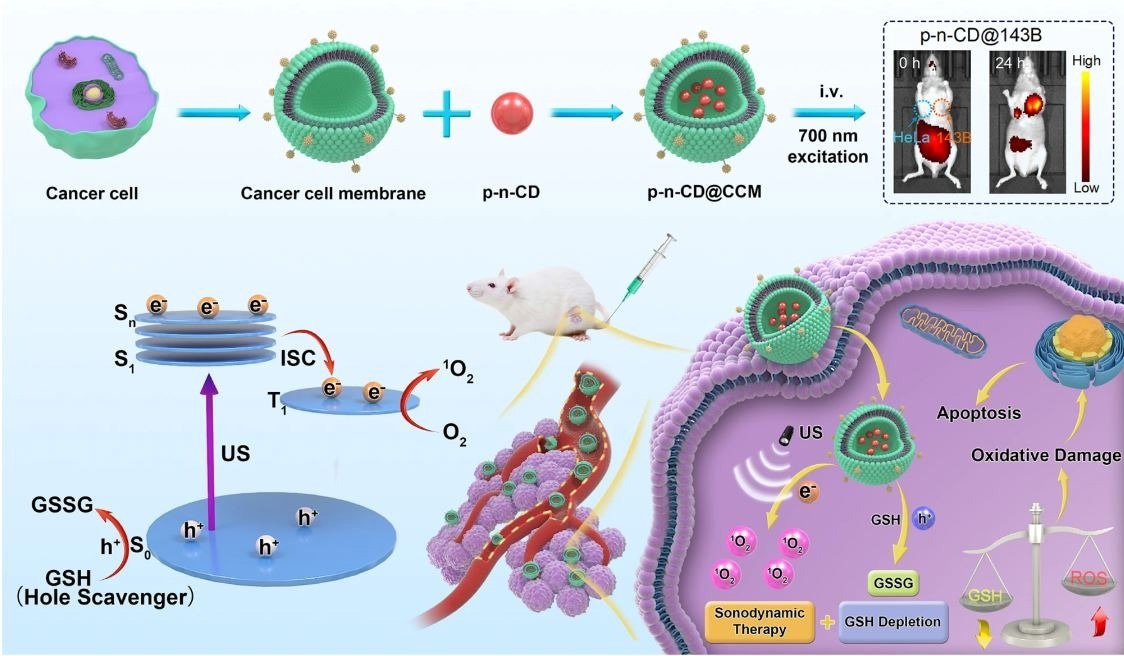Imaging-guided sonodynamic tumor therapy requires new therapeutic sonosensitizers with integrated sonodynamic and near-infrared (NIR) imaging techniques. However, developing a single material with both NIR emitting capabilities and sonodynamic behavior remains a significant challenge

Study: Near-infrared phosphorescent carbon dots for sonodynamic precision tumor therapy. Image Credit: Lightspring/Shutterstock.com
A recent study published in the journal Nature Communications addresses this problem by describing novel NIR-emitting sonosensitizers for sonodynamic tumor therapy using NIR phosphorescent carbon dots (CDs) with a narrow bandgap and long-lived activated triplet modes.
What is Sonodynamic Tumor Therapy?
Sonodynamic tumor therapy, which uses sonosensitizers and low-intensity ultrasonic (US) radiations to produce anti-tumor reactive oxygen species (ROS) for triggering cancer cell apoptosis, has been showcased as an exciting non-invasive treatment approach. This is due to significant benefits in spreading tissue penetration depth and minimizing adverse effects.
In this context, several sonosensitizers derived from organic chemicals and metal-based inorganic nanocrystals have been produced for effective sonodynamic tumor therapy.
Although significant progress has been made in the burgeoning area of sonodynamic tumor therapy, low-yield ROS production from sonosensitizers is a fundamental constraint in therapeutic applications. As a result, manipulating thermodynamic and dynamical parameters that enhance the high-yield ROS formation of semiconductor sonosensitizers is very important.
A sonosensitizer's narrow bandgap is a desirable thermodynamic characteristic since it uses less energy to generate electron-hole pairs. Similarly, a sonosensitizer's longer excited-state lifespan is a positive dynamical factor since long-lived charge carriers can better engage in catalytic activities.
Near-Infrared (NIR) Phosphorescent Materials for Tumor Therapy
Based on the above considerations, it is reasonable to design a high-efficiency sonosensitizer with a small bandgap and a prolonged carrier lifespan for efficient charge carrier stimulation, dissociation, and chemical reactions. Nonetheless, conventional semiconductor sonosensitizers made of titanium dioxide have a large bandgap and a limited carrier lifespan, limiting their applicability.
With the emergence of targeted therapy, there is a growing interest in developing new therapeutic nanomedicines for targeted cancer treatment. However, potential therapeutic sonosensitizers with integrated sonodynamic and imaging modalities are urgently needed for image-guided sonodynamic tumor therapy.
Near-infrared (NIR) fluorescence dyes are often used to mark sonosensitizers. Unfortunately, dye labeling is hampered by poor photostability, widespread cytotoxicity, and high production costs.
Phosphorescent substances with room-temperature afterglow emissions have recently gained popularity for applications in optoelectronics, data protection, and time-resolved biomedical imaging with minimal noise. In particular, NIR phosphorescent substances can be engineered as efficient sonosensitizers because of their ultralong carrier lifespan and narrow bandgaps.
In this situation, producing NIR-phosphorescent substances from metal-free components with excellent bioactivity and inexpensive costs would be a game-changing strategy for investigating their phosphorescence imaging and sonodynamic tumor therapy.

Schematic illustration of cancer cell membrane encapsulated NIR-phosphorescent CDs with long-lived triplet excited states (T1) for tumor-specific NIR imaging and precision sonodynamic therapy. Geng, B. et al. (2022).
Sonodynamic Tumor Therapy using Carbon Dots
In this study, the researchers presented a new category of therapeutic platforms based on multifunctional carbon dots (CDs) with narrow bandgaps for NIR imaging-guided sonodynamic tumor therapy.
Microwave synthesis, a facile one-step production approach, was devised for the regulated creation of carbon dots with the conductivity types of carbon dots easily manipulated by sulfonic acceptors.
In contrast to previously developed preparation techniques, including complicated post-treatments and time consumption, the high-efficiency and one-step approach established in this work is appropriate for low-cost manufacturing of positive-negative (p-n) junction carbon dots.
Carbon dots with distinct electronic structures generated using this synthesis process have low energy carrier stimulation, high-efficiency charge isolation, and great promise for many current technologies, such as solar cells, photocatalytic compounds, and biomedical imaging.
Important Highlights of the Current Study
The as-prepared p-n carbon dots have a narrow bandgap and a prolonged carrier lifespan. These characteristics are thermodynamically and dynamically advantageous for improving sonodynamic tumor therapy under low-intensity ultrasonic irradiation.
NIR-phosphorescent carbon dots are bipolar quantum dots with positive (p-) and negative (n)-type surface functionalization areas that can promote the spatial dissociation of electron-hole pairs and rapid transfer to target sites.
Moreover, cancer cell membrane entrapment allows cancer-specific targeting and high-level intratumor concentration of therapeutic carbon dots for targeted tumor therapy with complete removal of solid tumors by single dose and single radiation.
These findings are expected to pave the way for a potential strategy for engineering phosphorescent substances with long-lived triplet excited states for sonodynamic tumor therapy.
Reference
Geng, B. et al. (2022). Near-infrared phosphorescent carbon dots for sonodynamic precision tumor therapy. Nature Communications. Available at: https://www.nature.com/articles/s41467-022-33474-8
Disclaimer: The views expressed here are those of the author expressed in their private capacity and do not necessarily represent the views of AZoM.com Limited T/A AZoNetwork the owner and operator of this website. This disclaimer forms part of the Terms and conditions of use of this website.